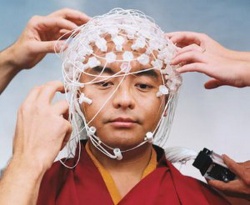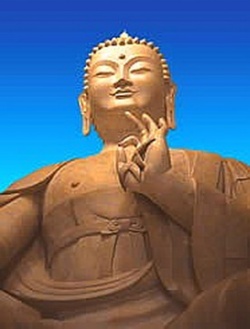The function of the Mind
The function of the Mind to see is dependent on the sensitive eye. If the sensitive eye does not function or is absent, as in the case of the blind, no mind arises to see. The function of the Mind to hear is dependent on the sensitive ear. Similarly for the other sense-objects, and the function of the Mind to see, hear, smell, etc., is dependent on their corresponding senses. There are different types of Mind. The Mind that sees is not the same as that which hears. When you see someone, the Mind arises where the object is visual Form; then you hear a sound, and the Mind arises with the sound as its object. But the visual Mind has to cease before the auditory Mind can commence.
So a new Mind arises with every new object.
Take a visual Consciousness. The Mind-Consciousness follows to recall the immediately past visual object and based on it, takes colour, shapes, persons, and things, and also thinks about them. Take an ear-Consciousness (of sound waves within the ear’s physical range). The Mind-Consciousness follows to recall the immediately past sound, and distinguish it from sounds previously heard so as to know whether it is that of a gun or a bell. Supposing that it is the sound of a gun. We have ear-Consciousness at first. Other consciousnesses follow to recall the sound, and investigate and determine what it is.
When it is determined that it is the sound of a gun, a mental reaction of fright will occur, but not in the case of a child or those who do not know what a gun can do. It means that whether you are disturbed or not depends on your mental response. In the act of hearing, the mental processes are: the mind hears a sound (ear Consciousness); a new mind recalls the word it has associated with the sound, e.g. dog; a new mind projects the word, dog, on to the sound and takes it as an object of the mind; a new mind mentally reads the word (dog).
The word "dog" is superimposed on the sound. Actually, the word and the sound are taken as one, which of course is wrong Take the sounds from a radio. If a Chinese song or talk emanates from the loudspeaker, you cannot understand a word of it; the words are not mentally connected up to give sense to the sounds. You must remember that only sounds are emitted from a radio, but you normally think that you hear words from the radio. Why? Because when the word associated with the sound appears, it has come from the mind. The word originated in the mind and therefore exists only in the mind. When we were young and learning to speak, particular words were associated with certain sounds.
It means that sounds and words are two different things, but we are wrongly apt to think them as one. We have actually superimposed the word on the sound. And these words are connected up to get the ideas behind them. Take the case of a person looking at an airplane in the sky. A second person comes along and he also looks up at the airplane in the sky. Actually, the second person could look at the first person or look at the plane, but in actual fact he looks at the plane, as if the first person was directing him to do so. Similarly for a third person or a fourth person; they all look up at the airplane in the sky. Instead of a person, let us think in terms of Mind. The first Mind is aware of the airplane, and we know that the Mind disappears immediately. A second Mind comes along. As if the first Mind has directed the second Mind to do so, it will be aware of the plane.
Actually the second Mind could turn its attention to the airplane or be aware of the first Mind. But can it be aware of the first Mind? It cannot be aware straightaway but must recall the first Mind after it has disappeared. It means that if the second Mind were to turn to the subject which is the first Mind, it becomes the object and ceases to be the subject. Even then, if we recall the past Mind, we are on the way to mind the Mind. But it will never do just to keep minding the Mind, for in order to learn anything, in the classroom or elsewhere, the Mind must be minding the objects and thinking about them and motivating verbal and physical actions.
That’s how meanings are given to the sequence of events, conclusions arrived at and practical results obtained. Take, for instance, the act of seeing a car. The mental processes are: The Mind knows the car as an external object, A second Mind calls up in the Mind the name which is "Car", and this name is the object of the Mind. A new Mind mentally projects the name on to the thing; the mentally projected name is an object within the mind. A new Mind takes the mentally projected name as an object within the Mind.
The above is expressed in the simplest and barest of terms. However, for a person to say, "I see a rose", there arise complicated processes of imagination, reproductive and constructive, memory, conception, discrimination, Judgement, classification, which all follow one another so rapidly in succession that the percipient considers that he "sees" the rose almost instantaneously. For an introduction of the thought-process see Chapter II, and the following quote from Nārada’s Abhidhammattha Sangaha: "The subject, the Consciousness, receives objects from within and without. When a person is in a state of profound sleep his mind is said to be vacant, or, in other words, in a state of bhavanga. We always experience such a passive state when our minds do not respond to external objects. This flow of bhavanga is interrupted when objects enter the mind.
Then the bhavanga Consciousness vibrates for one thought-moment and passes away. Thereupon the sense-door Consciousness (pañca-dvārāvajjana) arises and ceases. At this stage the natural flow is checked and is turned towards the object. Immediately after there arises and ceases the eye Consciousness (cakkhu Viññāna), but yet knows no more about it. This sense operation is followed by a moment of reception of the object so seen (sampaticchana). Next comes the investigating faculty (santīrana) or a momentary examination of the object so received.
After this comes that stage of representative cognition termed the determining Consciousness (votthapana). Discrimination is exercised at this stage. Freewill plays its part here. Immediately after there arises the {{Wiki|psychologically]] most important stage - Impulsion or javana. It is at this stage that an action is judged whether moral or immoral. Kamma is performed at this stage; if viewed rightly (yoniso Manasikāra), the javana becomes moral; if viewed wrongly (ayoniso Manasikāra), it becomes immoral. In the case of an Arahat this javana is neither moral nor immoral, but merely functional (kiriya). This javana stage usually lasts for seven thought moments, or, at times of Death, five. The whole process which happens in an infinitesimal part of time ends with the registering Consciousness (tadālambana), lasting for two thought moments - thus completing one thought-process at the expiration of seventeen thought-moments." etc.
The reader who is interested in the mental processes involved can look it up on p.32 of U Shwe Zan Aung’s Introductory Essay to the "Compendium of Philosophy" which is the translation of Abhidhammatha Sangaha, a sort of Vade-Mecum written by Anurudha Thera of Ceylon in about the 8th Century. The translation is rather difficult reading, and was first published in 1910. It must here be noted that the name is always an object with the mind and is not independent of the mind. But the thing and the name are taken to be one and the same; this is a perversion. When we want to communicate about anything to others we must use names. For the name calls up the thing to the minds of those who have also associated the name with the thing. That’s how we employ nouns to distinguish one thing from another. A noun is the name given to the thing. The thing is called a car; here the car is the name or noun. The thing and the name are two different things. But we usually say, "This is a car", "to buy a car", as if the name and the thing are one and the same. We should really say, "this is called a car".
That’s how wrong views about names and nouns come to be held. We must remember that names are mind-made words. We must understand that names exist only as objects of the mind, and not as objects outside or independent of the Mind. A car is not a single thing but made up of different parts which are inter-dependent. "Car" is a conventional word. Similarly, take the case of the name "John". Instead of knowing that the name "John" is only a name, it is believed that John is an external object independent of the Mind. But it is thought that John and one’s person are one and the same. Take the case of mental labeling of one’s person as "I".
Instead of one’s name, one usually uses the pronoun "I" to designate one’s person in speech and Writing. "I", like the name "John" is only a mental label which exists momentarily in the Mind. "I" exists only when mentally and verbally said. But we say "I" see, "I hear". etc., all the time. "I" is regarded as the subject, when it is only a mental label. The good thing about mind-Consciousness is that it synthesizes and connects up different minds. Take for example a lump, or a grain, of sugar. The first Mind sees the thing - visual Consciousness. The second mind grasps the name of the thing as sugar. The third Mind tastes the thing called sugar - gustatory Consciousness - and finds it sweet. The fourth Mind pronounces that sugar is sweet. Without the connecting up, we could not understand the happenings and experiences of the World.
Let us now turn to a consideration of Matter. The 4 Primary Essential Qualities or Properties of Matter, called Mahā Bhūta’s are:
- pathavī manifested as Hardness
- āpo manifested as Cohesion
- tejo manifested as Heat
- vāyo manifested as Resistance to Motion.
These 4 properties are separate but exist together. They function jointly, yet severally.
You can visualise their opposite qualities only by comparison. You see the colours of black and white only by comparison. You know good health only when you come to know bad health. Changeability is the very essence of matter. Matter is changing all the time, and matter and changeability are synonymous.


